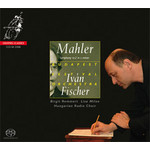
Mahler: Symphony no. 2 in c minor 'Resurrection'
 $75.00
Out of Stock
$75.00
Out of Stock6+ weeks add to cart
GUSTAV MAHLER
Mahler: Symphony no. 2 in c minor 'Resurrection'
Lisa Milne / Birgit Remmert / Budapest Festival Orchestra / Ivan Fischer
[ Channel Classics SACD / 2 Hybrid SACD ]
Release Date: Friday 20 October 2006
This item is currently out of stock. It may take 6 or more weeks to obtain from when you place your order as this is a specialist product.
"This Budapest band have reserves aplenty, and the cumulative effect is overwhelming. As all good performances of this work must be. I listened to it three times in three days."
(Gramophone Magazine Recording of the Month Awards Issue 2006)
Gramophone Awards 2007 - Editor's Choice
SACD/hybrid pcm, stereo, multichannel
"I read many an over the top review of this disc before obtaining a copy myself. All I had read came nowhere near the experience of an actual listen. This is as much a landmark recording of this quintessential symphony you will ever have the pleasure to hear. It is to this decade what Rattles was to the 1980's. And the similarities do not stop there. Fischer has been quietly working this band of skilled players into magnificent ensemble in much the same way the Simon (now sir Simon) Rattle did with the City of Birmingham Symphony Orchestra. I have never encounted such meticulous preparation of this score before, and those that think Gilbert Kaplan had the measure of the piece need to think again."
(http://audioenz.co.nz/)
"Iván Fischer has evidently been doing something very special in Budapest. Here, he and his Budapest Festival Orchestra deliver a version of Mahler's Resurrection Symphony that goes right to the top of the catalogue (well, it's at least in the top five). Unusually, Fischer keeps the leash tight during the white-knuckle first movement, husbanding his forces for the work's later stages. But there are enough hints of the power they can unleash to keep you on the edge of your seat. At the same time, he reveals textures and details that are usually submerged. The result is a performance which builds to an awesome climax, while at the same time taking a level-headed look deep into the work's spiritual heart. In that sense, you might compare it to Giulini's famous rethink of Verdi's Requiem. But for those who like their Mahler Two to blow them out of their seats, fear not; this Budapest band have reserves aplenty, and the cumulative effect is overwhelming. As all good performances of this work must be. I listened to it three times in three days."
(Gramophone Magazine Recording of the Month Awards Issue 2006)
"Ivan Fischer's reputation is as one of music's great iconoclasts, so it is no surprise that this recording offers radical insights into a work that some had considered interpretatively exhausted. It's a taut, angry performance, political as well as religious in tone, that links the musical language of apocalyptic uncertainty with that of imperial decline. Much of it sounds more like Schubert run to seed than post-Wagnerian overdrive - it won't please everyone. The dark, slightly raw sound of the Budapest Festival Orchestra won't appeal to those who prefer the smooth approach of Karajan or Haitink in Mahler. Fischer's speeds can also sometimes seem idiosyncratic, with the Urlicht section and the final chorales taken much faster than usual.The closing pages, however, attain a remarkable sense of elated urgency, while the whole symphony, usually considered disjointed, comes over as exceptionally cogent, with not a duff passage or wasted note to be heard. Highly recommended." ***** (5 stars out of 5) GUARDIAN.CO.UK
'Resurrection' Mahler's Second Symphony, 'Resurrection' (1894) is a gigantic work of enormous proportions, extreme contrasts, and a score that surpasses even his First Symphony from two years earlier. Ten horns, eight trumpets, two harps, organ, five percussionists, two vocal soloists (soprano and alto), as well as a large mixed chorus, fill the podium. And behind all this, invisible, is a 'Fernorchester' (distant orchestra) as a symbol of 'the resurrection'. The work lasts for some 80 to 85 minutes, twice as long as Brahms's Fourth or the Franck and D'Indy symphonies of the same period. And relative to a Haydn or Mozart symphony, there is a tripling in size. Only Bruckner approaches it in the length department with his Fifth and Eighth, each lasting about 75 minutes. But then Mahler, in this symphony, is dealing with the themes of life, death, and resurrection, and he took whatever space he felt that he needed. There is a strangely sharp contrast between the untroubled key of C major and the dark and turbulent contents of the work. It has been suggested that the theme of life, death, and resurrection was borne in on Mahler on the occasion of the funeral of the great conductor Hans von Bülow in 1894. In any case, the words of Klopstock that were read on that occasion are the same ones that Mahler used that year for the apotheosis (last movement) of his Second Symphony: "Aufersteh'n, ja aufersteh'n wirst du, mein Staub, nach kurzer Ruh unsterblich Leben wird der dich rief gegeben." (Thou shalt arise, yes, arise, my dust, after a brief slumber, thou shalt be called to immortal life). And Mahler expanded the text further with his own words: "O glaube, mein Herz. Es geht dir nichts verloren. Dein ist was du gesehnt. Dein, was du geliebt, was du gestritten. O glaube: Du wardst nicht umsonst geboren. Hast nicht umsonst gelebt, gelitten." (O have faith, my heart. Nothing shall be lost to thee. What thou hast longed for is thine. Thine remains, what thou hast loved, what thou hast battled for. O have faith: thou wast not born for nothing. Thou hast not suffered in vain.) From liner notes (Clemns Romijn)
![Auserlesene mit Ernst und Lust gemengte Instrumentalmusik [Concerto Grossi] cover](https://images.marbecks.co.nz/_thumbnails/10146/10146409.jpg)


